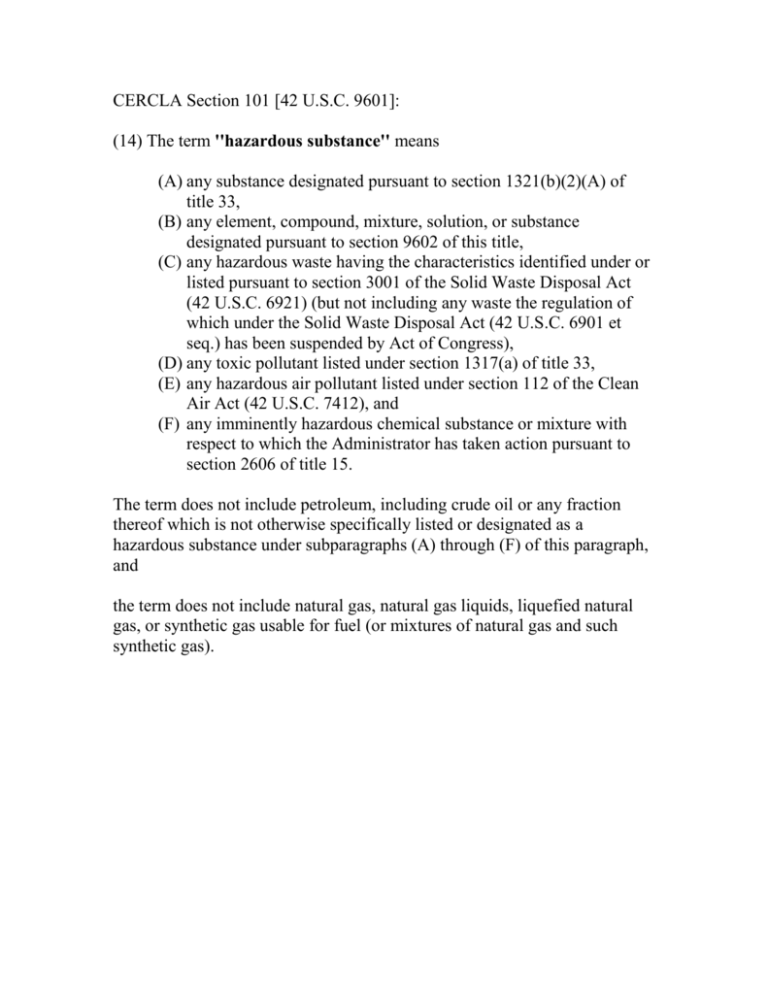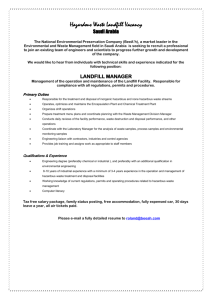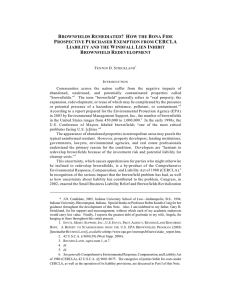CERCLA Section 101 [42 U
advertisement

CERCLA Section 101 [42 U.S.C. 9601]: (14) The term ''hazardous substance'' means (A) any substance designated pursuant to section 1321(b)(2)(A) of title 33, (B) any element, compound, mixture, solution, or substance designated pursuant to section 9602 of this title, (C) any hazardous waste having the characteristics identified under or listed pursuant to section 3001 of the Solid Waste Disposal Act (42 U.S.C. 6921) (but not including any waste the regulation of which under the Solid Waste Disposal Act (42 U.S.C. 6901 et seq.) has been suspended by Act of Congress), (D) any toxic pollutant listed under section 1317(a) of title 33, (E) any hazardous air pollutant listed under section 112 of the Clean Air Act (42 U.S.C. 7412), and (F) any imminently hazardous chemical substance or mixture with respect to which the Administrator has taken action pursuant to section 2606 of title 15. The term does not include petroleum, including crude oil or any fraction thereof which is not otherwise specifically listed or designated as a hazardous substance under subparagraphs (A) through (F) of this paragraph, and the term does not include natural gas, natural gas liquids, liquefied natural gas, or synthetic gas usable for fuel (or mixtures of natural gas and such synthetic gas). CERCLA Section 101 [42 U.S.C. 9601]: (22) The term ''release'' means any spilling, leaking, pumping, pouring, emitting, emptying, discharging, injecting, escaping, leaching, dumping, or disposing into the environment (including the abandonment or discarding of barrels, containers, and other closed receptacles containing any hazardous substance or pollutant or contaminant), but excludes (A) any release which results in exposure to persons solely within a workplace, with respect to a claim which such persons may assert against the employer of such persons, (B) emissions from the engine exhaust of a motor vehicle, rolling stock, aircraft, vessel, or pipeline pumping station engine, release of source, byproduct, or special nuclear material from a nuclear incident, as those terms are defined in the Atomic Energy Act of 1954 (42 U.S.C. 2011 et seq.), . . . , and (D) the normal application of fertilizer. 42 U.S.C. 9607 [CERCLA 107]: (a) . . . Notwithstanding any other provision or rule of law, and subject only to the defenses set forth in subsection (b) of this section (1) the owner and operator of a vessel or a facility, (2) any person who at the time of disposal of any hazardous substance owned or operated any facility at which such hazardous substances were disposed of, (3) any person who by contract, agreement, or otherwise arranged for disposal or treatment . . ., and (4) any person who accepts or accepted any hazardous substances for transport to disposal or treatment facilities, incineration vessels or sites selected by such person, …, shall be liable for (A) all costs of removal or remedial action incurred by the United States Government or a State or an Indian tribe not inconsistent with the national contingency plan; (B) any other necessary costs of response incurred by any other person consistent with the national contingency plan; (C) damages for injury to, destruction of, or loss of natural resources, including the reasonable costs of assessing such injury, destruction, or loss resulting from such a release; and (D) the costs of any health assessment or health effects study carried out under section 9604(i) of this title. 42 U.S.C. 9607 [CERCLA 107] (cont'd): (b) Defenses -- There shall be no liability under subsection (a) of this section for a person otherwise liable who can establish by a preponderance of the evidence that the release or threat of release of a hazardous substance and the damages resulting therefrom were caused solely by (1) an act of God; (2) an act of war; (3) an act or omission of a third party other than an employee or agent of the defendant, or than one whose act or omission occurs in connection with a contractual relationship, existing directly or indirectly, with the defendant . . . , if the defendant establishes by a preponderance of the evidence that (a) he exercised due care. . . , and (b) he took precautions against foreseeable acts or omissions of any such third party and the consequences that could foreseeably result from such acts or omissions; or (4) any combination of the foregoing paragraphs.











